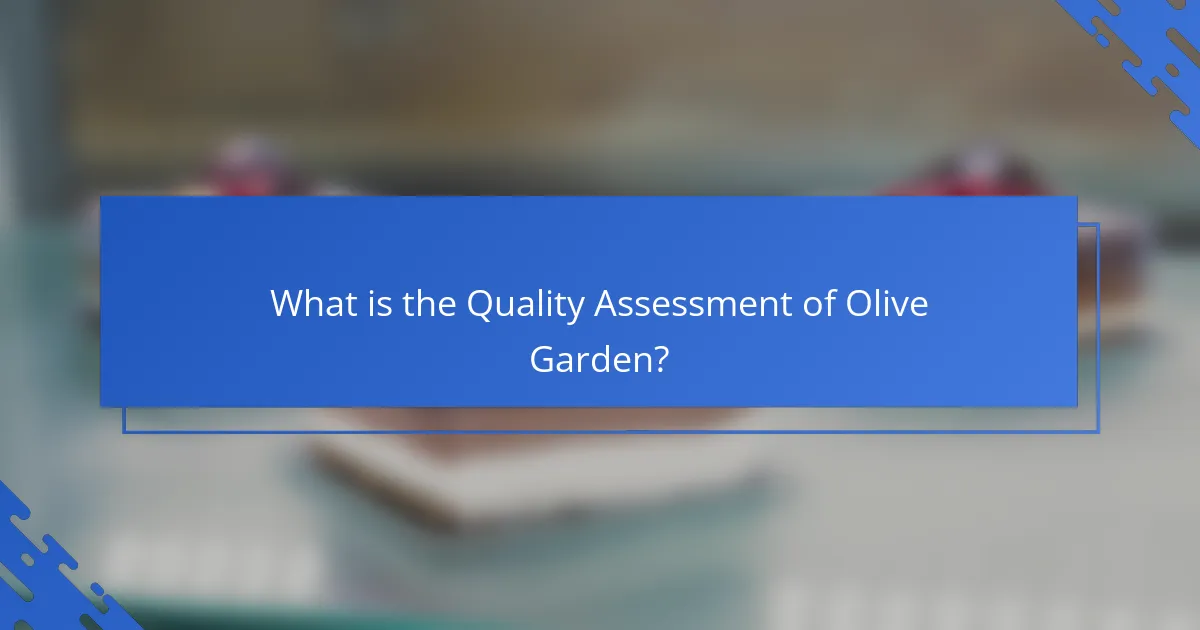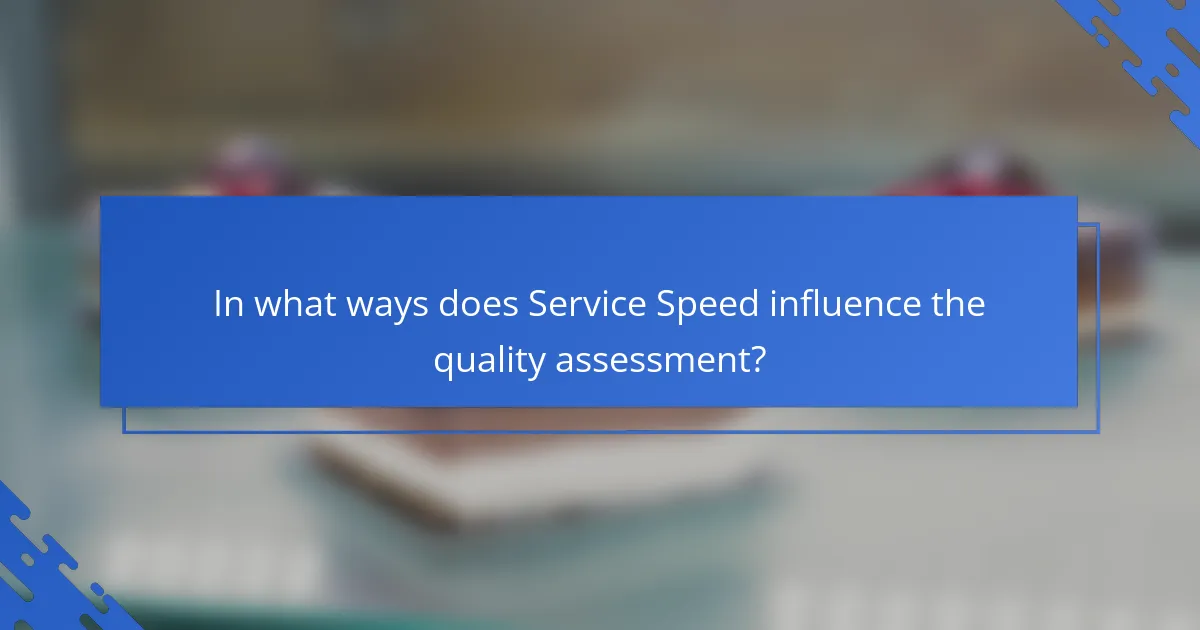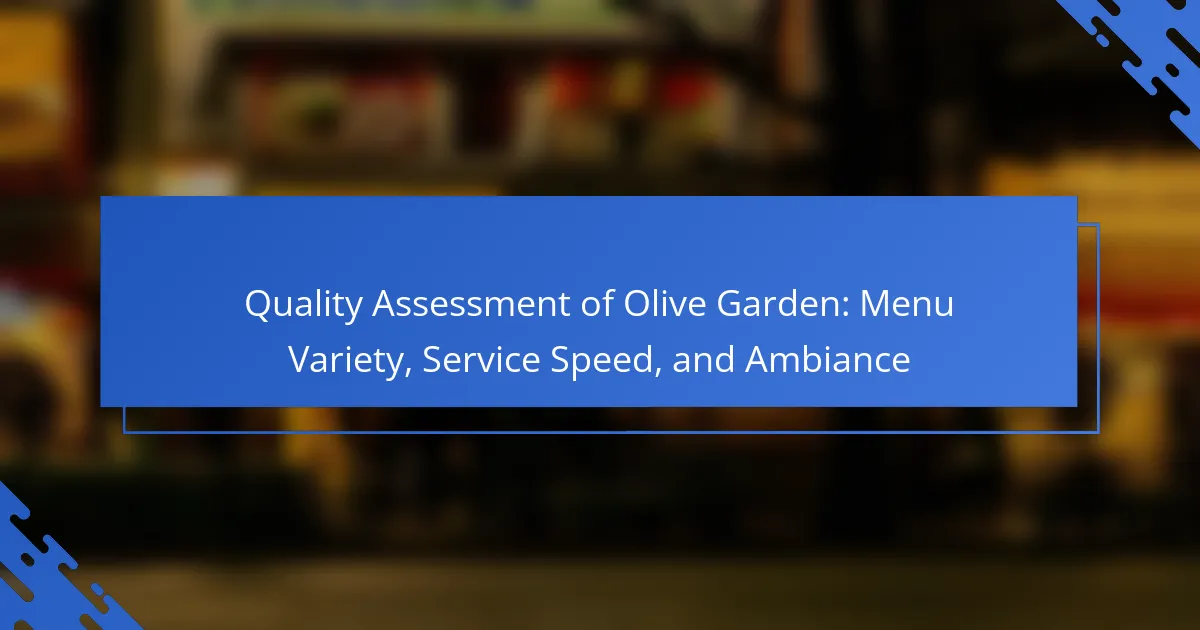The article focuses on the quality assessment of Olive Garden, a popular Italian-American restaurant chain. It evaluates three key factors: menu variety, service speed, and ambiance. Customers generally report a mixed to positive experience, highlighting the extensive menu that caters to diverse dietary preferences and enhances satisfaction. Service speed is also noted as a crucial element, with timely meals contributing to positive dining experiences. Additionally, the family-friendly and casual ambiance of Olive Garden plays a significant role in customer retention and overall perception of quality.

What is the Quality Assessment of Olive Garden?
The quality assessment of Olive Garden generally indicates a mixed to positive experience. Customers often praise the menu variety, which includes numerous Italian-American dishes. Service speed is typically rated as satisfactory, with many locations providing timely meals. However, some reviews note inconsistencies in service quality across different locations. The ambiance is often described as family-friendly and casual, contributing to a welcoming dining atmosphere. According to customer reviews on platforms like Yelp and TripAdvisor, Olive Garden maintains a solid reputation for providing value in terms of food quality and portion sizes.
How is the overall quality of Olive Garden evaluated?
The overall quality of Olive Garden is evaluated through customer feedback, food quality, and service efficiency. Customer feedback includes reviews and ratings on platforms like Yelp and TripAdvisor. Food quality is assessed based on freshness, taste, and presentation of dishes. Service efficiency is measured by wait times and staff responsiveness. Olive Garden’s ambiance also plays a role, encompassing decor, cleanliness, and overall atmosphere. These factors collectively contribute to the restaurant’s quality assessment.
What criteria are used in the quality assessment?
The criteria used in the quality assessment include menu variety, service speed, and ambiance. Menu variety evaluates the range of dishes offered and their appeal to customers. Service speed measures the efficiency of staff in delivering food and beverages. Ambiance assesses the overall dining environment, including decor and comfort. These criteria are essential for determining customer satisfaction and overall dining experience.
How does customer feedback influence the quality assessment?
Customer feedback significantly influences quality assessment by providing direct insights into customer experiences. Feedback highlights areas of satisfaction and dissatisfaction regarding menu variety, service speed, and ambiance. This information allows Olive Garden to identify strengths and weaknesses in their offerings. For instance, positive feedback can reinforce successful practices, while negative feedback can prompt necessary improvements. Research shows that 70% of customers are more likely to return to a restaurant that actively seeks and responds to feedback. By analyzing trends in customer comments, Olive Garden can adapt its strategies to enhance overall quality.
What are the key components of Olive Garden’s quality assessment?
The key components of Olive Garden’s quality assessment include menu variety, service speed, and ambiance. Menu variety refers to the range of dishes offered, ensuring options for different dietary preferences. Service speed evaluates how quickly customers receive their meals after ordering. Ambiance encompasses the restaurant’s atmosphere, including decor, lighting, and overall comfort. These components are essential for maintaining customer satisfaction and loyalty. Olive Garden regularly reviews these aspects through customer feedback and internal evaluations to enhance the dining experience.
How does menu variety contribute to the overall quality?
Menu variety enhances overall quality by catering to diverse customer preferences. A wider selection allows for more personalized dining experiences. This variety can increase customer satisfaction and loyalty. Studies show that restaurants with diverse menus often report higher customer retention rates. Additionally, menu variety can stimulate repeat visits as customers seek to try new dishes. Olive Garden’s extensive menu aligns with this principle, offering options for various dietary needs. The result is an elevated dining experience that appeals to a broader audience.
What role does service speed play in customer satisfaction?
Service speed significantly impacts customer satisfaction. Faster service often leads to higher satisfaction levels among customers. Studies show that 70% of customers cite speed as a crucial factor in their dining experience. When service is prompt, customers feel valued and are more likely to return. In contrast, slow service can lead to frustration and negative reviews. Efficient service enhances the overall dining experience, making customers more likely to recommend the establishment. Thus, service speed is a key component in achieving high customer satisfaction.
How does ambiance affect the dining experience at Olive Garden?
Ambiance significantly enhances the dining experience at Olive Garden. The restaurant employs warm lighting and Italian-themed decor to create a welcoming atmosphere. This environment encourages relaxation and enjoyment during meals. Research indicates that ambiance influences customer satisfaction and perceived value in dining settings. A study by Kwortnik and Thompson (2009) found that atmosphere impacts diners’ emotional responses and overall experience. Additionally, Olive Garden’s music selection contributes to a pleasant dining experience, promoting a sense of comfort. Overall, the carefully curated ambiance at Olive Garden plays a crucial role in customer enjoyment and satisfaction.

How does Menu Variety impact the quality assessment of Olive Garden?
Menu variety significantly impacts the quality assessment of Olive Garden. A diverse menu caters to a wider range of customer preferences. This variety enhances customer satisfaction and encourages repeat visits. According to a study by the National Restaurant Association, diverse menus attract more diners. Customers appreciate having options that suit different dietary needs. Additionally, menu variety can lead to higher perceived value. When customers feel they have more choices, they are likely to rate their experience more positively. Olive Garden’s extensive menu contributes to its reputation for quality dining.
What types of dishes are available on the Olive Garden menu?
Olive Garden offers a variety of dishes including pasta, soups, salads, and entrees. Their pasta dishes feature options like fettuccine Alfredo and lasagna. Soups include minestrone and chicken gnocchi. Salads are highlighted by the famous Garden Salad and Caesar Salad. Entrees feature grilled chicken, seafood, and steak options. Additionally, Olive Garden serves a selection of appetizers and desserts. The diverse menu caters to different dietary preferences and tastes.
How does Olive Garden cater to different dietary preferences?
Olive Garden caters to different dietary preferences by offering a diverse menu that includes vegetarian, gluten-free, and lighter fare options. The restaurant provides a dedicated gluten-free menu featuring items like gluten-free pasta and sauces. Vegetarian options include dishes such as Eggplant Parmigiana and various salads. Additionally, Olive Garden offers customizable meals to accommodate specific dietary needs. The menu also highlights nutritional information, helping guests make informed choices. These practices demonstrate Olive Garden’s commitment to inclusivity in dining.
What seasonal or limited-time offerings enhance menu variety?
Seasonal or limited-time offerings that enhance menu variety include specialty dishes and themed promotions. Olive Garden often introduces seasonal items such as autumn-inspired soups or summer pasta dishes. These offerings provide customers with unique flavors that reflect the time of year. For example, during the fall, they may feature pumpkin-based entrees. In the summer, lighter, fresher options are typically available. Limited-time promotions, like the Never Ending Pasta Bowl, create excitement and encourage repeat visits. These offerings not only diversify the menu but also attract customers looking for new dining experiences.
How does the variety of menu options affect customer satisfaction?
The variety of menu options significantly enhances customer satisfaction. A diverse menu caters to different tastes and dietary preferences. This inclusivity makes customers feel valued and understood. Research indicates that restaurants with extensive menus often see higher customer retention rates. A study published in the Journal of Foodservice Business Research found that variety directly correlates with positive dining experiences. Customers appreciate having choices, which can lead to repeat visits. Furthermore, menu variety can encourage customers to try new dishes, increasing their overall enjoyment. In essence, a broader menu contributes to a more satisfying dining experience.
What are the most popular dishes among customers?
The most popular dishes among customers at Olive Garden include the Chicken Alfredo, Lasagna Classico, and Shrimp Scampi. Chicken Alfredo features fettuccine pasta and a creamy Alfredo sauce. Lasagna Classico is a layered pasta dish with meat sauce and ricotta cheese. Shrimp Scampi consists of shrimp sautéed in garlic and olive oil, served with pasta. These dishes are frequently highlighted in customer reviews and menu rankings. According to a survey by Restaurant Business, these items consistently rank among the top choices for diners. Olive Garden’s emphasis on Italian-American cuisine contributes to the popularity of these dishes.
How does Olive Garden maintain consistency across its menu items?
Olive Garden maintains consistency across its menu items through standardized recipes and training. Each dish is prepared using specific ingredients and methods to ensure uniformity. Staff undergoes rigorous training to follow these guidelines precisely. Quality control measures are implemented at each location. Regular audits and feedback help uphold these standards. This approach ensures that customers receive the same experience regardless of location. Olive Garden’s commitment to consistency is a key aspect of their brand identity.

In what ways does Service Speed influence the quality assessment?
Service speed significantly influences quality assessment by impacting customer satisfaction and perceived value. Faster service often leads to a more positive dining experience. Customers associate prompt service with efficiency and attentiveness. Research indicates that service speed can directly affect repeat patronage. A study found that 70% of diners prioritize speed alongside food quality. Additionally, long wait times can result in negative reviews and decreased overall ratings. Therefore, service speed is a critical factor in evaluating the quality of a dining establishment like Olive Garden.
What factors contribute to the speed of service at Olive Garden?
The speed of service at Olive Garden is influenced by several key factors. Efficient staff training ensures employees are well-prepared to handle customer requests promptly. The restaurant’s layout facilitates smooth movement for servers, reducing delays. A streamlined menu design allows for quicker order processing. Use of technology, such as digital ordering systems, enhances communication between the kitchen and servers. High customer turnover during peak hours can also accelerate service as staff becomes more adept at managing multiple tables. These elements collectively contribute to a faster dining experience at Olive Garden.
How does staff training impact service efficiency?
Staff training significantly enhances service efficiency. Trained staff are more knowledgeable about menu items, leading to quicker customer service. This reduces wait times and improves order accuracy. According to a study by the American Society for Training and Development, organizations that invest in training see a 24% increase in productivity. Well-trained employees can handle customer inquiries and issues more effectively. This results in higher customer satisfaction and retention rates. In the context of Olive Garden, efficient service can lead to increased table turnover and revenue. Overall, effective staff training is crucial for optimizing service processes.
What are typical wait times for food and service at Olive Garden?
Typical wait times for food and service at Olive Garden range from 10 to 30 minutes. This timeframe applies to both food preparation and initial service. Factors influencing wait times include restaurant location, time of day, and customer volume. During peak hours, such as weekends, wait times may extend. Conversely, during off-peak hours, service may be quicker. Customer reviews often indicate satisfaction with the speed of service. Olive Garden aims for efficient service to enhance the dining experience.
How does service speed correlate with customer experiences?
Service speed directly impacts customer experiences. Faster service generally leads to higher customer satisfaction. Studies show that 70% of customers value quick service as a key factor in their overall experience. Delays can result in frustration and negative perceptions. For instance, a survey by the American Customer Satisfaction Index found that speed of service significantly influences dining experiences. Restaurants that prioritize efficient service often see repeat business and positive reviews. In contrast, slow service may deter customers from returning. Therefore, optimizing service speed is crucial for enhancing customer experiences in restaurants like Olive Garden.
What feedback do customers provide regarding service speed?
Customers frequently provide feedback indicating that service speed at Olive Garden varies. Many customers express satisfaction with prompt service during peak hours. Reports show that wait times for food delivery are generally acceptable, averaging around 15 to 20 minutes. However, some customers mention delays during busy periods, particularly on weekends. Specific reviews highlight instances where food was served quickly, enhancing the dining experience. Conversely, other feedback points to slower service when the restaurant is crowded. Overall, customer feedback reflects a mix of positive and negative experiences regarding service speed at Olive Garden.
How does Olive Garden address service speed issues?
Olive Garden addresses service speed issues by implementing streamlined processes and staff training. The restaurant utilizes a system that prioritizes efficient kitchen operations. This includes pre-prepared ingredients for quicker meal assembly. Additionally, Olive Garden trains staff to enhance table turnover rates. The waitstaff is instructed to manage customer needs promptly. They also leverage technology for order processing to reduce wait times. These measures collectively improve overall service speed.

What is the significance of Ambiance in the quality assessment of Olive Garden?
Ambiance significantly impacts the quality assessment of Olive Garden. A pleasant ambiance enhances the dining experience for customers. Factors such as lighting, decor, and music contribute to this atmosphere. Research indicates that a well-designed ambiance can increase customer satisfaction. Studies show that 70% of diners consider ambiance crucial when choosing a restaurant. Olive Garden’s warm and inviting environment aligns with its brand identity. This creates a comfortable space for families and friends to gather. Consequently, ambiance plays a vital role in customer retention and overall perception of quality.
What elements define the ambiance at Olive Garden?
The ambiance at Olive Garden is defined by warm lighting, Italian-themed decor, and a family-friendly atmosphere. Warm lighting creates a cozy and inviting environment. Italian-themed decor includes murals and rustic furnishings, enhancing the cultural experience. The family-friendly atmosphere encourages gatherings and celebrations. Background music features soft Italian melodies, contributing to a relaxed vibe. Comfortable seating arrangements facilitate conversation and connection among diners. The overall design promotes a sense of community and comfort. Olive Garden’s ambiance aims to provide a welcoming dining experience for all guests.
How does interior design contribute to the dining experience?
Interior design significantly enhances the dining experience by creating an inviting atmosphere. The layout influences the flow of service and guest interaction. Color schemes can evoke specific emotions, impacting diners’ moods. Lighting plays a crucial role in setting the ambiance, affecting how food is perceived. Comfortable seating arrangements encourage longer visits and increased spending. Thematic decor can enhance the restaurant’s brand identity, making it memorable. Research indicates that well-designed spaces can increase customer satisfaction by up to 30%. Therefore, effective interior design is essential for a positive dining experience.
What role does music and lighting play in creating ambiance?
Music and lighting significantly influence the ambiance of a space. Music sets the emotional tone and can enhance the dining experience. Studies show that background music can affect customers’ moods and perceptions of wait times. For instance, slower tempos can create a relaxed atmosphere, while upbeat music may energize guests. Lighting contributes by affecting visibility and mood. Dim lighting often creates intimacy, while bright lighting can enhance alertness. Together, music and lighting create a cohesive environment that aligns with the overall dining experience. Research indicates that establishments with carefully curated music and lighting report higher customer satisfaction.
How does ambiance affect customer perceptions of quality?
Ambiance significantly affects customer perceptions of quality. A well-designed ambiance enhances the dining experience, making customers feel more comfortable and valued. Research indicates that elements like lighting, music, and decor influence mood and satisfaction levels. For instance, a study published in the Journal of Retailing found that pleasant ambient conditions lead to higher perceived quality and increased spending. Additionally, restaurants with inviting atmospheres receive better reviews and repeat visits. This correlation highlights the importance of ambiance in shaping customer expectations and experiences.
What are customer opinions on the atmosphere at Olive Garden?
Customers generally describe the atmosphere at Olive Garden as welcoming and family-friendly. Many appreciate the warm lighting and Italian-themed decor. The ambiance is often noted for being comfortable and conducive to conversation. Customers frequently mention the spacious seating arrangements, which enhance the dining experience. Some reviews highlight the restaurant’s ability to accommodate large groups. Overall, the atmosphere is considered inviting for both casual dining and special occasions. Positive feedback often emphasizes the combination of friendly service and pleasant surroundings.
How can ambiance improvements enhance the overall dining experience?
Ambiance improvements can significantly enhance the overall dining experience by creating a more inviting and comfortable environment. Factors such as lighting, music, and decor contribute to the atmosphere of a restaurant. Research indicates that pleasant lighting can elevate mood and encourage longer visits. A study from the Cornell University School of Hotel Administration found that background music influences dining duration and customer satisfaction. Furthermore, well-designed decor can stimulate conversation and enhance social interactions among diners. Improved ambiance can also lead to increased customer retention and repeat visits, as a positive atmosphere is often a key factor in dining choices.
What are some best practices for evaluating the quality of Olive Garden?
To evaluate the quality of Olive Garden, assess menu variety, service speed, and ambiance. Menu variety can be evaluated by reviewing the range of dishes offered. Check for seasonal specials and dietary options. Service speed can be assessed by noting wait times for seating and food delivery. Observe staff attentiveness and efficiency during service. Ambiance evaluation involves considering the restaurant’s cleanliness, decor, and noise levels. Customer feedback, including online reviews, can provide additional insights into these aspects. Consistency across multiple visits can also indicate overall quality.
How can customers provide constructive feedback on their experiences?
Customers can provide constructive feedback on their experiences through various channels. They can use comment cards available at the restaurant. Online surveys sent via email after dining are also effective. Social media platforms allow customers to share their thoughts publicly. Customers can leave reviews on restaurant review sites like Yelp or Google. Direct communication with management during or after the meal can facilitate immediate feedback. Engaging in conversations with staff can also yield valuable insights. These methods enable customers to express their opinions and suggestions clearly. Constructive feedback helps improve service quality and overall dining experiences at establishments like Olive Garden.
What should diners consider when assessing their visit to Olive Garden?
Diners should consider menu variety, service speed, and ambiance when assessing their visit to Olive Garden. Menu variety includes options for different dietary preferences, such as vegetarian and gluten-free choices. The restaurant’s signature unlimited breadsticks and salad are popular highlights. Service speed is crucial for overall dining experience, with average wait times reported at around 10-15 minutes for food. Ambiance plays a role in comfort, with Olive Garden typically featuring a family-friendly atmosphere and Italian-themed decor. Evaluating these factors can help diners form a comprehensive view of their experience at Olive Garden.
The main entity of this article is Olive Garden, a popular Italian-American restaurant chain. The article provides a quality assessment of Olive Garden, focusing on three key attributes: menu variety, service speed, and ambiance. It evaluates customer experiences based on feedback regarding the diversity of menu options, the efficiency of service, and the overall dining atmosphere. Additionally, it discusses how these factors contribute to customer satisfaction and retention, highlighting the importance of consistent quality across all locations. Insights from customer reviews and studies are integrated to illustrate the impact of these attributes on the overall perception of Olive Garden’s dining experience.
